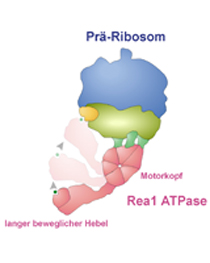New Light on a Mechanoenzyme with Motor Head and Mobile Tail

| |
|
Structure of the preribosome (blue) with bound Rea1 ATPase (pink) and other biogenesis factors (light and dark green, yellow). The Rea1 ATPase consists of a motor head and a long mobile tail that dock to two different sections of the preribosome. The generation of vectorial force by the motor head removes biogenesis factors (green and yellow) via the tail.
|
Scientists at the Universität Heidelberg and the University of Edinburgh have identified the hitherto unknown function of a mechanoenzyme involved in ribosome formation. This new type of cellular tool consists of a motor head and a long flexible tail. This device enables the enzyme to generate tensile force and thus intervene in the production of ribosomal subunits. In conjunction with a genetic template ribosomes are responsible for protein synthesis in the cell. The research findings have been published in the Cell journal.
Protein synthesis known as “translation” is one of the crucial biochemical processes in all cells. The process is mediated by ribosomes using a template (messenger RNA) from the nucleus to produce proteins from amino acids in the cytoplasm. The ribosomes themselves consist of two subunits, one large and one small, each made up of some 80 individual components. As Prof. Dr. Ed Hurt of Heidelberg University’s Centre for Biochemistry indicates, the construction of ribosomal subunits is highly complicated and takes place mainly in the cell nucleus.
Immature ribosome precursors take shape during a series of a very complicated construction steps. Like on an assembly line, the preribosomes have to go through a number of closely coordinated assembly stages before the matured ribosomal subunits leave the cell nucleus on their way to the cytoplasm. Over 200 helper proteins assist in ribosome construction. They bind to the evolving preribosomes and act on them. Later these biogenesis factors are removed so that the assembled ribosome can go about its work.
Operative in this maturation process is a molecular tool, an enzyme called Rea1 ATPase. It consists of a motor head and a long flexible tail, both of which can dock to the preribosome. Subsequently the molecular motor uses ATP (energy) to build up a tensile force. This force can be compared to a spiral spring and is transmitted to the ribosome precursor via the tail. The force finally releases biogenesis factors from the pre-ribosomal particles, explains Professor Hurt, who headed the research work with Dr. Bettina Böttcher, University of Edinburgh.
The aim of further research will be to decipher the molecular details of Rea1’s power stroke and how this is regulated. For more details on the research go to http://www.uni-heidelberg.de/zentral/bzh/hurt
Original publication
C. Ulbrich, M. Diepholz, J. Baßler, D. Kressler, B. Pertschy, K. Galani, B. Böttcher, E. Hurt: Mechanochemical Removal of Ribosome Biogenesis Factors from Nascent 60S Ribosomal Subunits, Cell 138, 911-922, 4 September 2009, doi:10.1016/j.cell.2009.06.045
Web and news desks, please note:
Digital picture material can be requested from the Press Office (see below).
Contact
Prof. Dr. Ed Hurt
Centre for Biochemistry
phone: +49 6221 544173
ed.hurt@bzh.uni-heidelberg.de
Communications and Marketing
Press Office, phone (06221) 54-2311
presse@rektorat.uni-heidelberg.de

